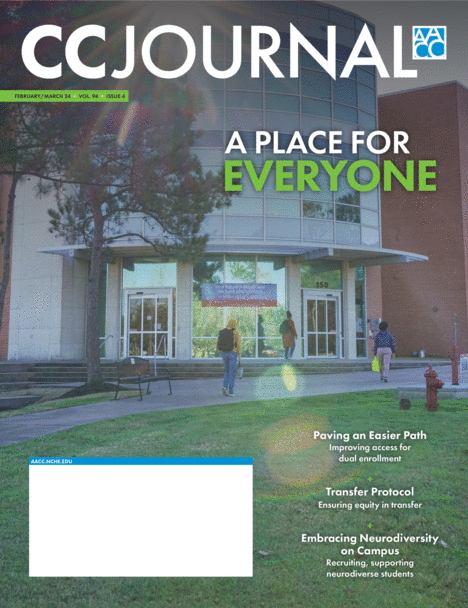Community colleges suffered steep enrollment losses during the Covid-crisis. Today, many two-year institutions continue to stabilize their rolls largely through dual enrollment, even as college leaders strive to attract the students who can benefit the most.
Racial and income gaps in community college access are still common, although the number of dual-enrollment programs and participants has grown significantly in recent years. According to a 2020 study from the Community College Research Center (CCRC) at Columbia University, an estimated 2 million high-school students register for dual enrollment courses every year, up from 1.4 million a decade ago.
This article is an excerpt from the current issue of the Community College Journal, the bimonthly magazine of the American Association of Community Colleges.
The report also found that while 12% of white students participate in dual enrollment at community colleges, these programs did not integrate Black (7%) or Hispanic (8%) learners nearly as successfully. Additionally, only one in five dual-enrollment efforts nationwide have mitigated or eliminated access gaps in race and income for their participants.
DEEP dive
Reaching marginalized students for dual-enrollment programs requires clearly identifying their interests and potential career pathways, note two CCRC reports released in 2023. CCRC recommends a model rooted in guided pathways, which allows learners to explore programs supported by their career and educational goals.
This revamped strategy, known as “dual enrollment equity pathways” (DEEP), loops in both underserved students and their families to encourage program participation. The model also links course offerings to career-technical associate and bachelor’s degree programs in potentially lucrative fields.
Although programming connecting high schools to community colleges is not uncommon, DEEP supports dual enrollment at a larger scale, says the 2023 CCRC study. Lee College, among several Texas institutions to adopt DEEP, studied matriculation rates and course-taking patterns to identify which student subgroups were most underrepresented.
“This has focused primarily on disaggregated data on income and the representativeness of students of color as well as gender,” says President Lynda Villanueva. “We use data to ensure that these groups are appropriately represented in academic pathways that lead to careers that provide family-sustaining wages.”
Lee College officials are keenly aware of the lax approach some two-year schools take to dual enrollment. Too often, colleges determine course offerings based on instructor availability instead of increasing student access to a field of interest, Villanueva says.
The lack of access naturally shuts out first-generation students, learners of color, and other historically underprivileged populations. It’s no wonder that dual enrollment is sometimes derided as a “program of privilege,” says Villanueva, who likens some dual-enrollment curriculum to a Cheesecake Factory menu.
“It’s so overwhelming; there are so many pages of offerings,” Villanueva says. “So, we give our students a defined set of discreet paths that align to strong labor market outcomes.”
A family affair
Lee College currently works with 13 area school districts on its dual-enrollment offerings, taking a proactive advising approach to ensure student success, Villanueva says.
“We tag team with the schools so our counselors and theirs are working together,” she says. “Having students who aren’t properly advised is only going to decrease the strength of our outcomes.”
Programming without intentionality is useless, adds Villanueva, who frames such efforts as “random acts of dual enrollment.” CCRC’s research in recent years revealed more colleges marrying dual enrollment to guided pathways practices. In this emerging approach, institutions partner with students and their families to build participant confidence upon matriculating.
“The focus on the family is much more strategic; much more hand-in-hand and coordinated with our high school partners,” Villanueva says. “There’s lots of intentional focus on advising and hosting family nights, because none of this works without families involved. Our job is to educate the entire family so they understand that the community is in this together.”
Strengthening partnerships
Florida’s Tallahassee Community College (TCC) employed a renewed marketing approach to benefit Black and Hispanic families unfamiliar with dual enrollment, notes Anthony Jones, vice president for academic affairs.
TCC, which also uses the DEEP program model, hosts parent nights led by a dual-enrollment coordinator. The coordinator visits area high schools to assist with advising and registering, while all recruitment activities delivered by the college have information on dual-enrollment opportunities.
“We inform parents and guardians of students participating in our summer camps, which serves as a primer to plan academic pathways as early as middle school,” Jones says. “A year or two ago we started dual-enrollment nights at our basketball games. Students invite friends who are not in dual enrollment, and during the evening they can talk to advisors for more information.”
The college is in contact with partner school districts on pressing community workforce needs. Conversations with high school administrators and EMS officials spurred the creation of an emergency medical technician program that provides training and certification to senior-level students who can then earn an EMT certificate from TCC.
Moreover, a newly TCC-authorized STEM charter school brings tuition-free workplace skills to 9th-12th graders from districts at or below the poverty line.
“We made a very intentional plan to engage area students for post-secondary enrollment,” says Sheri Rowland, TCC’s vice president of student affairs. “We’re talking to charter schools and home-schooled students to make sure kids know what it means to be in dual enrollment.”


